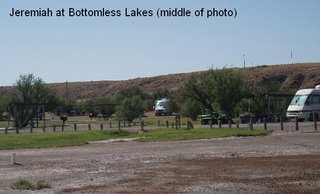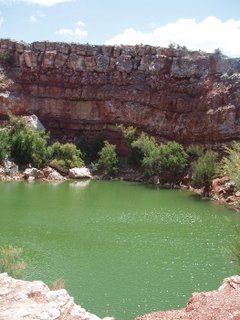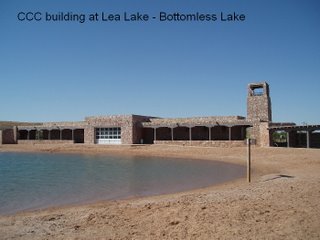Are the lakes really bottomless?

Today was a travel day between Brantley Lake and Bottomless Lakes state parks – a short (less than 70 miles) trip that took me through Roswell – famous for its “alien invasion” in 1947 and less famous for its dairy industry that provides milk for the world’s largest mozzarella factory located in this southeastern New Mexico city.
Roswell also is home to the New Mexico Military Institute (military prep high school and junior college founded in 1891), the International Law Enforcement Academy, a transit bus manufacturer and numerous aviation-related businesses.
The town really plays up the UFO connection – even Walmart has a large UFO souvenir section.
I made stops in Roswell to get groceries, post to my blog and answer email. One email was from Penny Shar, a lady I had met last November at Percha Dam State Park. Her message said she was back from her medical mission in Guatemala and was in southern New Mexico. We connected by phone and when she found out I would be at Bottomless Lakes, Penny said she would alter her route a bit and meet me there!

After my town errands, I continued on about a dozen more miles to Bottomless Lakes.
The road to the park drops down from some bluffs and loops around some small lakes. This series of eight lakes are actually sinkholes ranging in depth from 17 to 90 feet. They were formed when circulating underground water dissolved salt and gypsum deposits to form subterranean caverns. Eventually the roofs of the caverns collapsed from their own weight, resulting in sinkholes that soon filled with water from underground aquifers and springs. The lakes do have bottoms, contrary to the “bottomless” name. The illusion of great depth and the greenish-blue color are created by algae and other aquatic plants covering the lake bottoms.
The lake names are: Cottonwood, Mirror, Devil’s Inkwell, Lazy, Figure-Eight, Pasture, Lost and Lea (90- feet deep and the largest).

This was New Mexico’s first State Park, founded in 1933; the following year the CCC (civilian conservation corps) built a large day-use structure and water tower at Lea Lake. This lake is popular with the locals for swimming, scuba diving, and enjoying paddle boats and canoes that are available in the summer.

Even though the lakes and soils are mildly salty, making it impossible to grow most plants, cowboys herding cattle through in the 1800s used this area as stopover. The only plants that grow here are the tamarisk (salt cedar), mesquite, bush muhly, saltbrush, snakeweed, creosote and salt grasses. So far all efforts to successfully plant other trees have failed.
Roadrunners, meadowlarks, turkey vultures, rabbits, small rodents, raccoons and lizards are some of the critters that call this home. I’ve enjoyed watching birds eat at the feeders I put out.
The RV sites, with electricity and water, are located near Lea Lake; I settled into space 32 on the end of an oval with several tamarisk trees. I have a covered picnic table. Paul and Betsy are in space 31, and when Penny arrived later in the day, she went into space 12 across from me.
Lkkkkkkkkkkkoiu8 (Cat just walked across my keyboard and “wrote” you a greeting!) Cat would also like to tell you that she got a good whack on her head, but doesn’t seem to be affected by it. I was opening my clothes cabinet near my bed at the same time she was jumping up on the bed. I opened the door just as she jumped – she and the door collided and she fell to the floor. Ouch! I do let her outside here, and she sticks pretty close. There is a short, dead tamarisk tree near that she likes to climb. She is a “cautious risk-taker” – and that’s how I see myself. My two favorite risk-taking quotes are:

"If we did all the things we are capable of doing, we would astound ourselves." - Thomas Edison
“Risk is what separates the good part of life from the tedium.”
- American musician Jimmy Zero

<< Home